This week it felt as if the earth yanked up the winter scenery and slammed down the spring backdrop with a dramatic flourish. Though hills of blackened snow still line the edges of parking lots and especially shady areas still feel frosty, the sun is persistent, and the birds agree it’s time to get nesting. Right on cue from stage left, I was delighted to detect a trio of treefrogs as they chirruped from my determined little pond, the year’s first. I could hear their distinct voices, all ka-reeking and trilling males, each boasting of his genetic superiority to any females in the vicinity.
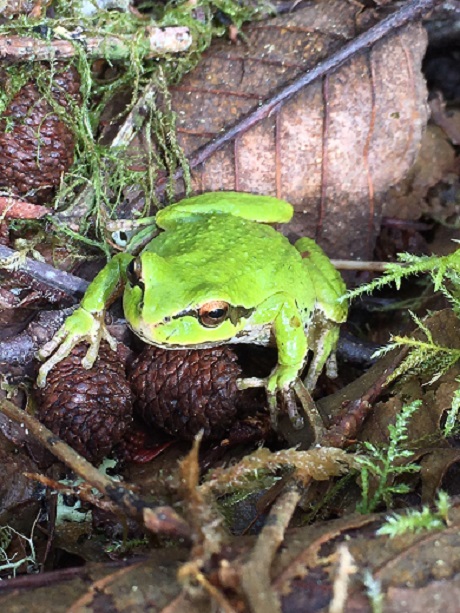
All over the island, thousands of small suitors are tuning up their voices for the annual love-in. Though they grow to just two inches, their voluble voices make up a spring symphony that is an oft-used Hollywood nighttime sound effect. Our most widespread native amphibians, Pacific treefrogs (Pseudacris regilla), live in every county in the state and are the official Washington state amphibian.
Treefrogs spend most of the year solo, reeling in arthropods—spiders and insects—with their sticky tongues in woods and gardens. Contrary to their name, they stay near the ground hidden in shrubs and grasses, sometimes staking out flower heads at their own “pollinator buffets.” When the weather gets cold, they go into a state called torpor, a kind of suspended animation in which their body temperature lowers and their breathing, heart and metabolic rates slow to nearly a full stop. This allows treefrogs to survive, even if a foot of snow falls in February. They just head for cover (under a bush, porch, tree or flowerpot) and wait.
This week the warmer temperatures signaled male treefrogs to wake up and make a beeline to nearby wetlands where they establish territories and serenade females out of hiding. The males follow the cues of a bout leader, the lead singer of the loud, two-part advertisement calls used for wooing — generally described as a “rib-it” or “krek-ek.”
Virile lead singers
The bout leader is a dominant male sought by females. He has the best quality pitch that scientists believe relates to strong health and reproductive fertility. Males make sounds by inflating a dark-gray throat sac that swells to three times their head size. If you find a treefrog, the presence or absence of this sac will tell you if it’s male or female.
Females might listen for days before coming to the ponds to choose a mate. As a female draws near her favorite crooner, the male jumps on her back and wraps her in a hug called amplexus (Latin for “embrace”). They may stay conjoined for several hours as she swims through the reeds, but fertilization happens later. After this encounter, the female attaches a quarter-sized gelatinous mass of 10 to 70 eggs to stems or sticks in shallow water. As she releases the eggs, the male fertilizes them. The female leaves the pond within the week, while her mate may stay up to a month or more, seeking to extend his genetic reach.
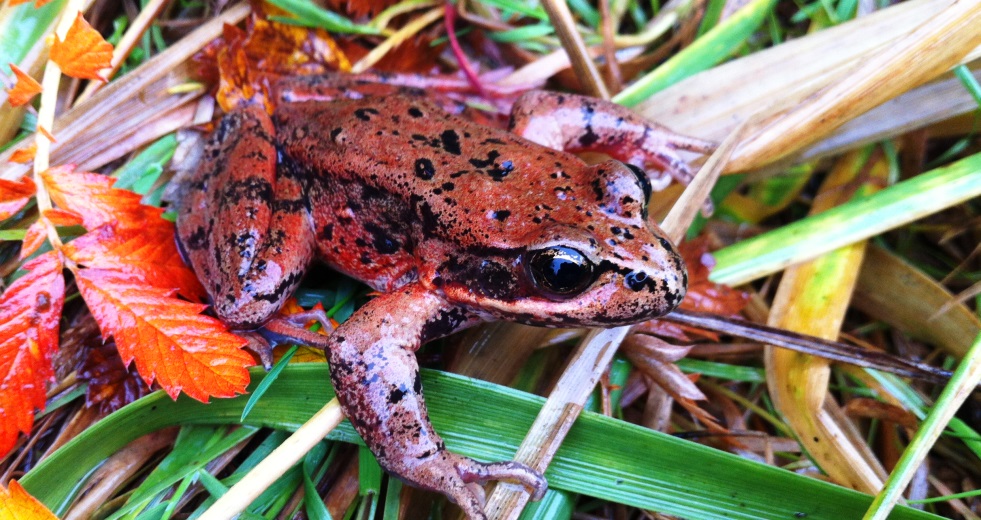
Tandem migrations
Treefrogs are not the only local amphibians migrating to ponds this time of year. Red-legged frogs (Rana aurora), which live most of the year along the cool edges of ponds and streams (like Shinglemill Creek) but can be found far from water during wet conditions, are also pond breeders (they lay their eggs in a gelatinous mass that can be as large as a cantaloupe; often the egg clusters are found in groups).
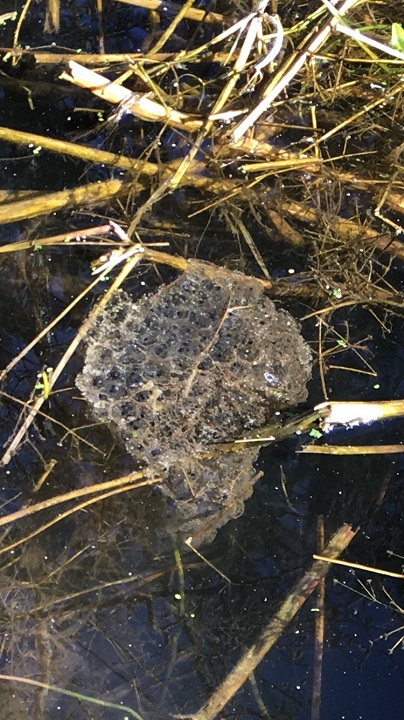
Our only other local frog, the introduced Bullfrog (Rana catesbeiana), is an import from the southern US and partial to warmer breeding temps. You can find its sticky sheets of eggs (described as poppy seeds tossed on slime) trapping ill-fated insects on the water’s surface from mid- to late May. It takes only two days for the young to emerge!
Aquatic salamanders, like the Long-toed (Ambystoma macrodactylum) are also bound for watery mating grounds. The earliest local amphibians to breed, Long-toeds have likely already deposited their eggs in ephemeral seasonal pools. This strategy, which helps avoid predation by the larvae of other salamanders and insects, may have backfired this year because our long stretch of cold weather could have frozen the eggs (sadly, not in the hopeful cryogenic sense), if the selected nursery was too shallow. The chunky, slow-moving (at least on land) Northwestern salamander (Ambystoma gracile) attaches a grapefruit-sized egg mass to a stick or sturdy stem up to two meters below the water surface (look for these impressive gelatinous balls at Christiansen Pond). Rough-skinned newts (Taricha granulosa) prefer mating waters with plenty of plants (find them at Lost Lake and Fisher Pond). Lucky hikers sometimes happen upon a mass migration of newts, when the forest floor comes alive with newts ambling along, pointed pond-ward.
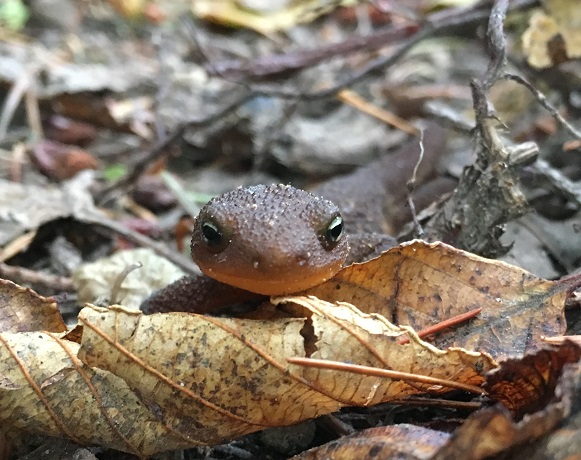
Gary Shugart, a member of the Vashon Nature Center science advisory council and head curator if collections at the Slater of Museum of Natural History in Tacoma has been keeping an eye on amphibians at Fisher Pond since 2006. For those who want to see newts on the move, he suggests heading to Fisher the night of the first warm rain; bring a flashlight and watch your step. (Oh, and don’t pick them up—their skin is poisonous to humans, but only if ingested.)
Many migratory paths to island breeding ponds cross roads, so keep an eye out at night, and drive carefully.
Terrestrial bodies
Our islands are also home to two fully terrestrial salamanders, the bug-eyed Ensatina (Ensatina eschscholtzii), and the confusingly common-named Western Redback (Plethodon vehiculum)—its stripe is usually yellow—which lay their eggs underground, in logs or between rocks. Salamander moms from both species stay with their eggs until the young hatch out.
The Burke Museum is a great resource for learning more about amphibians, as is the California Herps website (useful for frog sounds). For a handy waterproof ID, check out Vashon Nature Center’s Field Guide to Amphibians and Reptiles of Vashon and Maury Islands. My favorite book resource is Amphibians of Oregon, Washington and British Columbia by Charlotte Corkran and Chris Thoms.
Special thanks to Gary Shugart and Klaus Richter, retired King County ecologist, for background for this article. I interviewed Klaus several years ago for another story and this quote is worth repeating: “Frogs are an integral part of our wetland ecosystem and extremely beneficial. But I wonder why we always have to justify protecting animals and plants; we don’t justify Mount Rainier or blue sky. We owe something to this world simply from an ethical standpoint.”

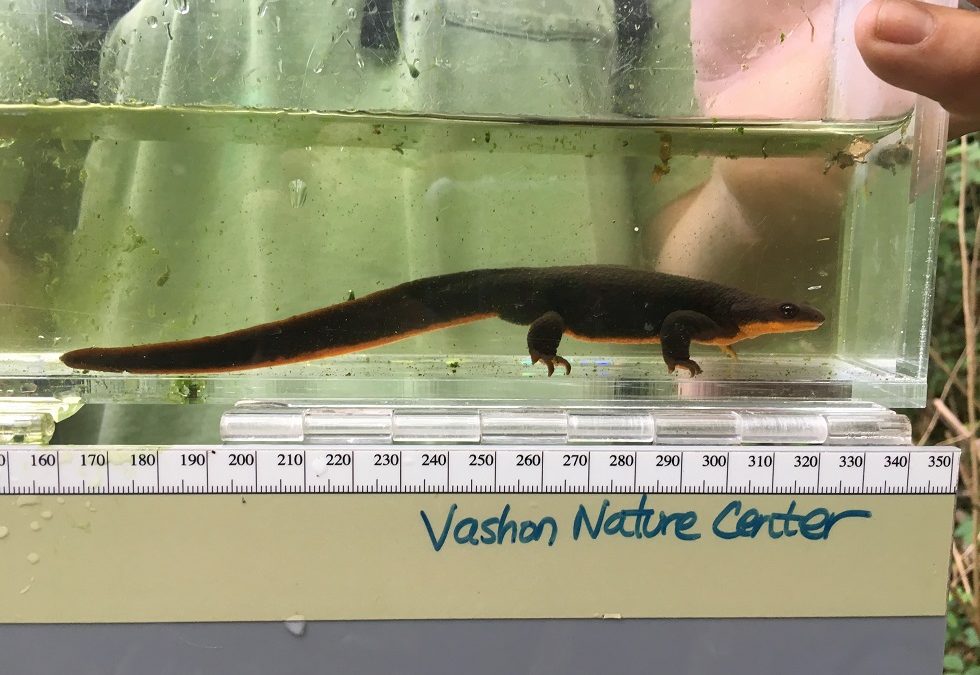
I hear tree frogs from my house, from a pond 500 yards away. Thank you for helping me appreciate what’s going on. Fascinating!
Hi Mark–yes, they sure can belt it out! It would be interesting to measure the song in decibels. You’re welcome, thanks for reading and commenting!
Lovely intro too late Spring.
Thanks, Jane! Any newts up and about near your place?
Is VNC still tracking bullfrog distribution on the island? Have eradication efforts helped? We have not had them in our pond (in the Christian Creek watershed) over the last few years.
Hi Ann, we aren’t actively tracking the populations. We do census for them during BioBlitz events. That’s interesting that you don’t have them in your pond anymore. Do you happen to have Northwestern salamanders in the pond? One thing we noticed when we did the BioBlitz at Christensen Pond is that bullfrog populations had been kept in check compared to studies there 10 years prior. One hypothesis we had was that the large neotenic NW salamanders were eating the bullfrog tadpoles. If you are in the same watershed maybe you have them too?
Yes! We do have salamanders. We see them rarely but enough to know they are there.
Lovely to think of the natural bio-control for an invasive species (although this is still in the hypothesis stage).
All the more reason to reduce disturbance in our natural areas on Vashon and to prioritize large, intact, corridor-rich protection across public and private lands on the island.